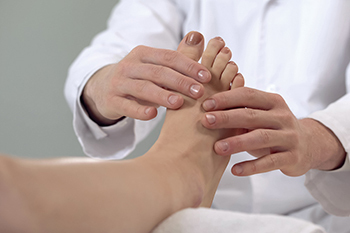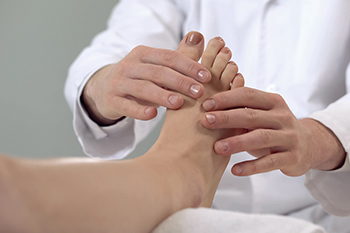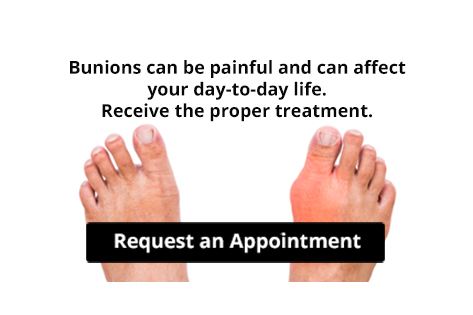Osteoarthritis of the Foot and Ankle

Osteoarthritis is a degenerative joint disease that affects joints in any part of the body, including the ankle and foot. Commonly affected joints of the foot are the ankle, the three joints of the hindfoot, the midfoot, and the big toe. Symptoms of osteoarthritis include stiffness and pain. There may also be swelling, a limited range of motion, bone spur development, and difficulty in walking. When one has osteoarthritis, cartilage, serving as a protective layer for the ends of bones that form joints, gradually wears down. Injury (such as severe sprains and fractures) and abnormal foot structure or mechanics (like flat feet) can lead to osteoarthritis. Other types of arthritis may mimic osteoarthritis, which is why it is important to consult with a podiatrist. Such a professional will provide a proper diagnosis and treatment options for you.
Arthritis can be a difficult condition to live with. If you are seeking treatment, contact Dr. Steven Shlonsky from Louisville, Kentucky. Dr. Shlonsky can provide the care you need to keep you pain-free and on your feet.
Arthritic Foot Care
Arthritis is a joint disorder that involves the inflammation of different joints in your body, such as those in your feet. Arthritis is often caused by a degenerative joint disease and causes mild to severe pain in all affected areas. In addition to this, swelling and stiffness in the affected joints can also be a common symptom of arthritis.
In many cases, wearing ill-fitting shoes can worsen the effects and pain of arthritis. Wearing shoes that have a lower heel and extra room can help your feet feel more comfortable. In cases of rheumatoid arthritis, the arch in your foot may become problematic. Buying shoes with proper arch support that contour to your feet can help immensely.
Alleviating Arthritic Pain
- Exercises that stretch the foot can prevent further pain and injury and increase mobility
- Most of the pain can be alleviated with anti-inflammatory drugs, heat, and topical medications
- Massages can help temporarily alleviate pain.
It is best to see your doctor for the treatment that is right for your needs and symptoms. Conditions vary, and a podiatrist can help you determine the right method of care for your feet.
If you have any questions, please feel free to contact our office located in Louisville, KY . We offer the newest diagnostic tools and technology to treat your foot and ankle needs.
Foot Wounds and Diabetes

Many individuals will suffer from a foot wound at some point in their life from some kind of cut, scrape, etc. While certain types of foot wounds can heal by themselves, individuals who suffer from diabetes might notice that it is more difficult for wounds on their bodies to heal. This is primarily due to the fact that when a diabetic’s blood sugar is abnormally high, the healing process is significantly slowed down. If you suffer from diabetes, you should not ignore wounds on your feet, as wounds left untreated can develop an infection. In very severe cases, untreated wounds may require amputation, and diabetics are more likely to undergo some kind of amputation procedure. Therefore, if you have diabetes, it might be wise to conduct a brief daily examination of your foot, scanning all parts of the foot (including between the toes) for any sign of a wound. Contact your podiatrist if you have a wound for proper treatment.
Wound care is an important part in dealing with diabetes. If you have diabetes and a foot wound or would like more information about wound care for diabetics, consult with Dr. Steven Shlonsky from Louisville, Kentucky. Dr. Shlonsky will assess your condition and provide you with quality foot and ankle treatment.
What Is Wound Care?
Wound care is the practice of taking proper care of a wound. This can range from the smallest to the largest of wounds. While everyone can benefit from proper wound care, it is much more important for diabetics. Diabetics often suffer from poor blood circulation which causes wounds to heal much slower than they would in a non-diabetic.
What Is the Importance of Wound Care?
While it may not seem apparent with small ulcers on the foot, for diabetics, any size ulcer can become infected. Diabetics often also suffer from neuropathy, or nerve loss. This means they might not even feel when they have an ulcer on their foot. If the wound becomes severely infected, amputation may be necessary. Therefore, it is of the upmost importance to properly care for any and all foot wounds.
How to Care for Wounds
The best way to care for foot wounds is to prevent them. For diabetics, this means daily inspections of the feet for any signs of abnormalities or ulcers. It is also recommended to see a podiatrist several times a year for a foot inspection. If you do have an ulcer, run the wound under water to clear dirt from the wound; then apply antibiotic ointment to the wound and cover with a bandage. Bandages should be changed daily and keeping pressure off the wound is smart. It is advised to see a podiatrist, who can keep an eye on it.
If you have any questions, please feel free to contact our office located in Louisville, KY . We offer the newest diagnostic and treatment technologies for all your foot care needs.
Dealing With Corns on the Feet

Corns on the foot develop from friction, usually as a result of a toe rubbing against the inside of a shoe. A callus, or toughened skin, develops with a hardened kernel at its center, thus the name corn. Most corns can be treated with a series of foot care measures, but people with diabetes, poor circulation, or foot deformities are wise to seek immediate help from a podiatrist. The first and best defense against developing a corn is to wear shoes that fit properly and to wear socks that form a kind of cushion, lessening friction. A warm foot bath can help soften the callused area, and a pumice can help to reduce its size. Keeping the feet moisturized also can help prevent the formation of a corn. A number of types of foot pads are available to protect the toe from further friction. It is not wise to try to remove a corn yourself with any sharp object, as this may lead to an infection. If a corn does not go away or causes severe pain, it is a good idea to make an appointment with a podiatrist who can treat the problem safely.
Corns can make walking very painful and should be treated immediately. If you have questions regarding your feet and ankles, contact Dr. Steven Shlonsky of Louisville, Kentucky. Dr. Shlonsky will treat your foot and ankle needs.
Corns: What Are They? And How Do You Get Rid of Them?
Corns are thickened areas on the skin that can become painful. They are caused by excessive pressure and friction on the skin. Corns press into the deeper layers of the skin and are usually round in shape.
Ways to Prevent Corns
There are many ways to get rid of painful corns such as:
- Wearing properly fitting shoes that have been measured by a professional
- Wearing shoes that are not sharply pointed or have high heels
- Wearing only shoes that offer support
Treating Corns
Although most corns slowly disappear when the friction or pressure stops, this isn’t always the case. Consult with your podiatrist to determine the best treatment option for your case of corns.
If you have any questions please feel free to contact our office located in Louisville, KY . We offer the newest diagnostic and treatment technologies for all your foot and ankle needs.
Preventing Heel Fissures

Cracked heels, or heel fissures, can look quite unattractive and can feel uncomfortable. This condition can affect a wide variety of individuals and it occurs when the skin on the back of the heels becomes so incredibly dry that the skin breaks or cracks. There are several steps that you might consider taking to prevent the onset of cracked heels. For example, you may try to keep your bare feet from being exposed to extreme hot or cold weather by covering your feet with appropriate dry socks and footwear. Additionally, to try to prevent cracked heels, one could be diligent about checking the ingredients in the soap used to clean one’s body, as soap can often dry out the skin. For instance, sodium lauryl sulfate and artificial fragrances are two main ingredients often used in soap products that can sometimes dry the skin out. Lastly, one could consider not using extremely hot water when taking a bath or shower. If you have heel fissures or are concerned about developing this condition, contact a podiatrist who can help you with this affliction.
Cracked heels are unsightly and can cause further damage to your shoes and feet. If you have any concerns, contact Dr. Steven Shlonsky from Louisville, Kentucky. Dr. Shlonsky can provide the care you need to keep you pain-free and on your feet.
Cracked Heels
Cracked heels appear unappealing and can make it harder for you walk around in sandals. Aside from looking unpleasant, cracked heels can also tear stockings, socks, and wear out your shoes. There are several methods to help restore a cracked heel and prevent further damage.
How Do You Get Them?
Dry skin is the number one culprit in creating cracked heels. Many athletes, walkers, joggers, and even swimmers suffer from cracked heels. Age and skin oil production play a role to getting cracked heels as well.
Promote Healing
Over the counter medicines can help, especially for those that need instant relief or who suffer from chronic dry feet.
Wear Socks – Wearing socks with medicated creams helps lock in moisture.
Moisturizers – Applying both day and night will help alleviate dryness which causes cracking.
Pumice Stones – These exfoliate and remove dead skin, which allows for smoother moisturizer application and better absorption into the skin.
Change in Diet
Eating healthy with a well-balanced diet will give the skin a fresh and radiant look. Your body responds to the kinds of food you ingest. Omega-3 fatty acids and zinc supplements can also revitalize skin tissue.
Most importantly, seek professional help if unsure how to proceed in treating cracked heels. A podiatrist will help you with any questions or information needed.
If you have any questions, please feel free to contact our office located in Louisville, KY . We offer the newest diagnostic and treatment technologies for all your foot care needs.








